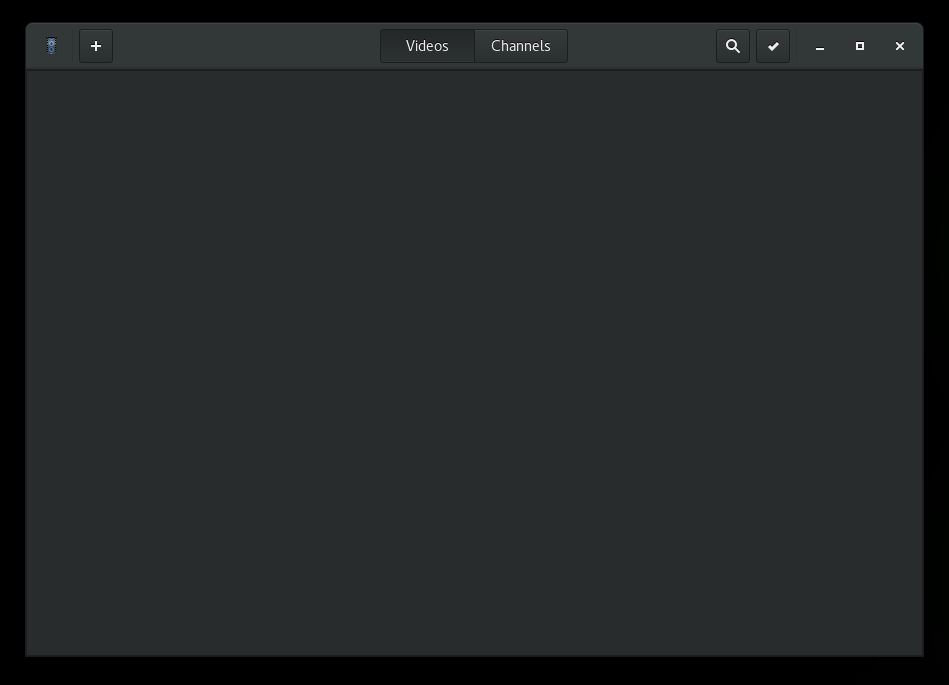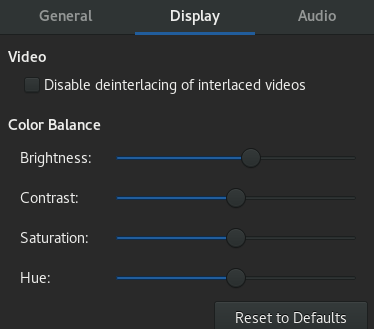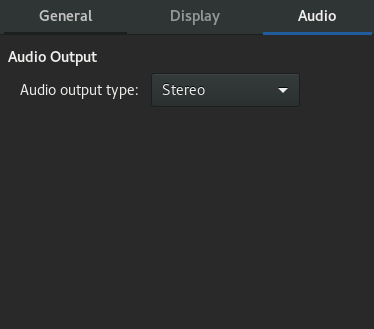18 #Edit source
GNOME Videos is the default movie player. GNOME Videos provides the following multimedia features:
Support for a variety of video and audio files
A variety of zoom levels and aspect ratios, and a full screen view
Seek and volume controls
Playlists
Complete keyboard navigation
To start GNOME Videos, open the Activities Overview by pressing Meta and search for video.
18.1 Using #Edit source
When you start GNOME Videos, the following window is displayed.
Figure 18.1: start-up window #
18.1.1 Opening a video or audio file #Edit source
Click › .
Select the files you want to open, then click
You can also drag a file from another application (such as a file manager) to the GNOME Videos window. GNOME Videos opens the file and plays the movie or song. GNOME Videos displays the title of the movie or song beneath the display area and in the titlebar of the window.
Note: Unrecognized file format
If you try to open a file format that GNOME Videos does not recognize, the application displays an error message and recommends a suitable codec.
You can double-click a video or audio file in GNOME Files to open it in the GNOME Videos window by default.
18.1.2 Opening a video or audio file by URI location #Edit source
Click › .
Specify the URI location of the file you want to open, then click .
18.1.3 Playing a DVD, VCD, or CD #Edit source
To play a DVD, VCD, or CD, insert the disc in the optical device of your computer, then click › .
To eject a DVD, VCD, or CD, click › .
To pause a movie or song that is playing, click the  button,
or click › . When you pause a movie or
song, the statusbar displays and the time elapsed
on the current movie or song.
button,
or click › . When you pause a movie or
song, the statusbar displays and the time elapsed
on the current movie or song.
To resume playing a movie or song, click the  button, or click › .
button, or click › .
To play or pause a movie, you can also press P.
To view properties of a movie or song, click › to make the sidebar appear. The dialog contains the title, artist, year, and duration of movie or song, video dimensions, codec, frame rate, and the audio bit rate.
18.1.4 Seeking through movies or songs #Edit source
To seek through movies or songs, use any of the following methods:
- To skip forward
Click › . Alternatively, use ←.
- To skip backward
Click › . Alternatively, use →.
- To move to next movie or song
Click › , or click the
 button.
button.
- To move to previous movie or song
Click › , or click the
 button.
button.
18.1.5 Changing the zoom factor #Edit source
To change the zoom factor of the display area, use any of the following methods:
- To zoom to full screen mode
Click › . Alternatively, press F.
To exit fullscreen mode, click or press Esc.
- To zoom to half size (50%) of the original movie or visualization
Click › › .
- To zoom to size (100%) of the original movie or visualization
Click › › .
- To zoom to double size (200%) of the original movie or visualization
Click › › .
To switch between different aspect ratios, click › .
The default aspect ratio is .
18.1.6 Showing or hiding controls #Edit source
To hide the window controls of GNOME Videos, click › and deselect the option. To show the controls on the GNOME Videos window, right-click the window, then select . If the Show Controls option is selected, GNOME Videos shows the menubar, time elapsed slider, seek control buttons, volume slider, and statusbar on the window. If the Show Controls option is not selected, the application hides these controls and shows only the display area.
18.1.7 Choosing subtitles #Edit source
To choose the language of the subtitles, click › › , then select the subtitles language (DVD) or subtitle file (AVI etc.) you want to display.
To disable the display of subtitles, click › › .
By default, GNOME Videos chooses the same language for the subtitles that you use on your computer.
GNOME Videos automatically loads and displays subtitles if the file that
contains them has the same name as the video file. It supports the
following subtitle file extensions: srt,
asc, txt,
sub, smi, or
ssa.
18.2 Modifying preferences #Edit source
To modify GNOME Videos preferences, click › in the Activities bar..
18.2.1 General preferences #Edit source
The General Preferences let you select a network connection speed, specify if media files should be played from the last used position, and change the font and encoding used to display subtitles.
Figure 18.2: general preferences #
General Preferences include the following:
- Playback
Lets you specify whether to start playing the movie from the last position.
- Networking
Select network connection speed from the Connection speed drop-down box.
- Text subtitles
Lets you specify whether to load the subtitles automatically, and change the font and encoding used to display the subtitles.
18.2.2 Display preferences #Edit source
The Display Preferences let you choose to automatically resize the window when a new video is loaded, change the color balance, and configure visual effects when an audio file is played.
Figure 18.3: display preferences #
Display Preferences include the following:
- Automatically resize the window when a new video is loaded
Select this option if you want GNOME Videos to automatically resize the window when a new video is loaded.
- Disable the screen saver when playing video or audio
Select this option if you want GNOME Videos to automatically disable the desktop screen saver while an audio file is playing.
- Visual effects
You can choose to show visual effects when an audio file is playing, select the type of visualization you want to show, and the visualization size.
- Color balance
Specify the level of color brightness, contrast, saturation, and hue.
18.2.3 Audio preferences #Edit source
The Audio Preferences dialog lets you select the audio output type.




